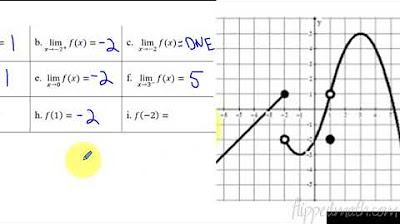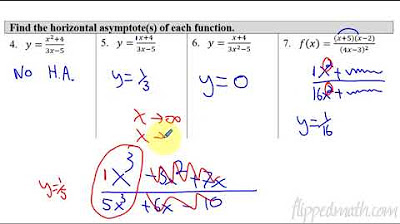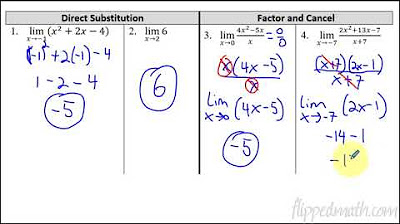Calculus AB/BC – 1.14 Infinite Limits and Vertical Asymptotes
TLDRIn this calculus lesson, Mr. Bean revisits the concept of vertical asymptotes with a twist. He explains the conditions for a vertical asymptote, emphasizing the importance of non-canceling factors in the numerator and denominator. The lesson delves into identifying one-sided limits and determining if the graph approaches positive or negative infinity. Mr. Bean provides examples without a graph, showcasing how to approximate limits by plugging in values close to the asymptote. The lesson concludes with the understanding that if left and right side limits are the same, the limit exists; otherwise, it does not.
Takeaways
- 📚 The lesson is about identifying vertical asymptotes and determining limits without a graph.
- 🔍 A vertical asymptote occurs when the denominator of a fraction equals zero and the factors don't cancel out.
- 📐 The presence of a hole in a function is indicated by factors that cancel out in the numerator and denominator.
- ✍️ The first vertical asymptote is identified at x equals three for the given function.
- 📉 To determine the direction of the asymptote (towards positive or negative infinity), one must approach the asymptote from both sides.
- 📈 The graph of a function with a vertical asymptote will show the function approaching either positive or negative infinity.
- 📝 When the left and right one-sided limits are not the same, the overall limit as x approaches a certain value does not exist (abbreviated as DNA).
- 🔢 To find the behavior of the function near a vertical asymptote without a graph, plug in values close to the asymptote from both sides.
- 🔄 Factoring the numerator and denominator can simplify the process of identifying vertical asymptotes and their behavior.
- 🤔 The direction of the function's approach to the asymptote (up or down) can be determined by substituting values close to the asymptote into the function.
- 🎓 The lesson concludes with the reminder that if the left and right one-sided limits are the same, the overall limit exists; otherwise, it does not.
Q & A
What is the main topic of Mr. Bean's calculus lesson?
-The main topic of the lesson is identifying vertical asymptotes and determining the behavior of a function as it approaches these asymptotes.
What is a vertical asymptote in the context of calculus?
-A vertical asymptote occurs when the denominator of a rational function equals zero and the factors do not cancel out, resulting in an undefined point on the graph.
How does Mr. Bean suggest identifying a vertical asymptote without a graph?
-Mr. Bean suggests identifying a vertical asymptote by looking at the factors of the numerator and denominator and checking if there is a common factor that cancels out, which would instead represent a hole in the graph, not an asymptote.
What is a hole in the graph of a function?
-A hole in the graph of a function occurs when a factor in both the numerator and the denominator cancels out, leaving a point where the function is not defined.
How can you determine the direction of a vertical asymptote without a graph?
-You can determine the direction of a vertical asymptote by approaching the asymptote from both the left and right sides and observing whether the function values are going towards positive or negative infinity.
What does Mr. Bean mean by 'one-sided limits'?
-One-sided limits refer to the behavior of a function as it approaches a certain point from the left (negative side) or right (positive side), rather than from both sides simultaneously.
Why might the limit as X approaches a certain value not exist?
-The limit as X approaches a certain value might not exist if the left and right one-sided limits approach different values, indicating a discontinuity at that point.
How does Mr. Bean demonstrate the approach to a vertical asymptote without a graphing calculator?
-Mr. Bean demonstrates the approach by plugging in a number very close to the point of the vertical asymptote, either from the left or right side, and observing the behavior of the function.
What is the significance of the function's behavior as it approaches a vertical asymptote?
-The behavior of the function as it approaches a vertical asymptote is significant because it indicates whether the function is unbounded and, if so, whether it tends towards positive or negative infinity.
How does Mr. Bean simplify the process of finding the limit as X approaches a certain value?
-Mr. Bean simplifies the process by using a factored form of the function and plugging in values close to the point of interest to approximate the limit without needing to graph the function.
What is the final topic Mr. Bean mentions for the next lesson?
-The final topic Mr. Bean mentions for the next lesson is horizontal asymptotes.
Outlines
📚 Introduction to Vertical Asymptotes and Limits
Mr. Bean begins the lesson by welcoming students to a calculus session focused on identifying vertical asymptotes and determining limits. He clarifies that a vertical asymptote occurs when the denominator of a fraction is zero and the factors do not cancel out, resulting in a hole in the graph. The first part of the lesson involves identifying the points where vertical asymptotes occur. The twist is determining the direction towards which the graph approaches the asymptote—whether it's negative or positive infinity—without visual aids like a graph or calculator. The teacher illustrates this with an example, explaining how to deduce the direction by considering the behavior of the function as it approaches the asymptote from both sides.
🔍 Analyzing One-Sided Limits at Vertical Asymptotes
The second paragraph delves into the concept of one-sided limits at vertical asymptotes. The teacher demonstrates how to calculate these limits by plugging in values that are infinitesimally close to the asymptote, from both the left and right sides. He uses an example to show that if the function approaches negative infinity from the left and positive infinity from the right, the overall limit at the asymptote does not exist because the left and right sides do not match. The teacher also emphasizes the importance of factoring the numerator and denominator to simplify the process of finding vertical asymptotes and their associated one-sided limits. The lesson concludes with a mastery check and a preview of the next lesson on horizontal asymptotes.
Mindmap
Keywords
💡Vertical Asymptote
💡Factored Numerator and Denominator
💡Hole
💡Limit
💡Infinity
💡One-Sided Limits
💡Graph
💡Denominator
💡Factor
💡Horizontal Asymptotes
Highlights
Introduction to identifying vertical asymptotes and determining limits.
Vertical asymptotes occur when the denominator equals zero and factors don't cancel.
A hole in a function is represented when something cancels out in the numerator and denominator.
The only vertical asymptote for the given function is at x equals three.
Identifying vertical asymptotes in a packet as part of the lesson exercise.
Approaching vertical asymptotes without a graph involves determining if the graph pushes up or down towards infinity.
The left and right one-sided limits at a vertical asymptote can be different, leading to a limit that does not exist.
An example of determining the direction of a graph near a vertical asymptote by plugging in values close to the asymptote.
The limit at a vertical asymptote can be approximated by using values close to the asymptote's x-value.
The concept of a limit not existing if the left and right sides approach different values.
Using factored forms of the numerator and denominator to simplify the process of finding vertical asymptotes.
An example of factoring to simplify the process of determining the behavior near a vertical asymptote.
The importance of checking both the left and right sides of an asymptote to determine the limit.
The method of using small adjustments to the x-value to find the direction of the graph near a vertical asymptote.
The conclusion that if left and right side limits are the same, the overall limit exists and is equal to that value.
Upcoming lesson预告 on horizontal asymptotes.
Transcripts
Browse More Related Video

Calculus AB/BC – 1.9 Connecting Multiple Representations of Limits

Calculus AB/BC – 1.3 Estimating Limit Values from Graphs

AP Calculus AB - 1.14 Connecting Infinite Limits and Vertical Asymptotes

Calculus AB/BC – 1.15 Limits at Infinity and Horizontal Asymptotes

Calculus AB/BC – 1.6 Determining Limits Using Algebraic Manipulation

Finding a Horizontal Asymptote of a Rational Function (Precalculus - College Algebra 40)
5.0 / 5 (0 votes)
Thanks for rating: